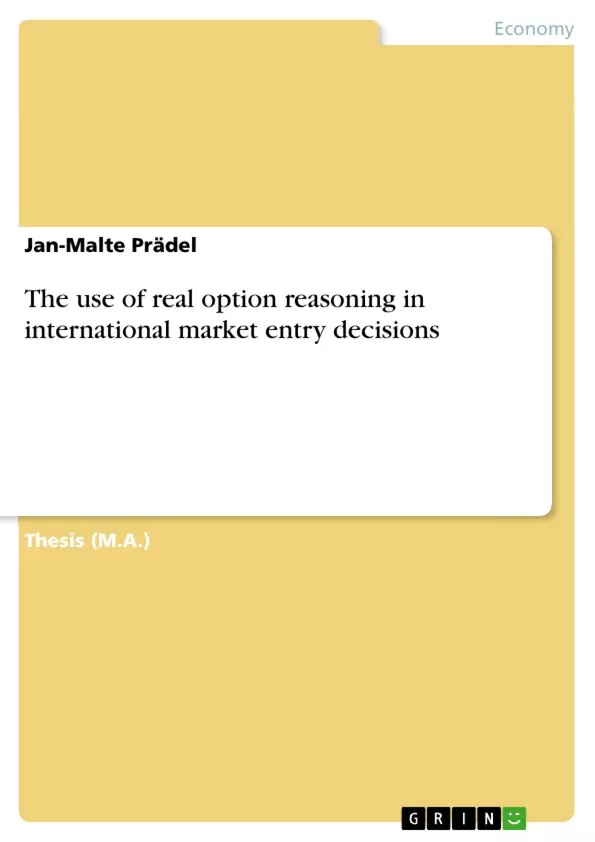Diese Arbeit analysiert und präsentiert die zusätzlichen Vorteile, welche die in der Realoptionstheorie angewandte Argumentation in Entscheidungen über internationale Markteintrittsstrategien bietet. Dafür werden zwei wissenschaftliche Stränge, die Theorie der Internationalisierung und die Realoptionstheorie, betrachtet. Beide werden zunächst hinsichtlich ihrer jüngsten Entwicklungen und Forschungsergebnisse separat analysiert.
Für die Theorie der Internationalisierung beinhaltet das vor allem die Diskussion der Vor- und Nachteile aus einem gesteigerten Grad an Internationalität sowie seinem Grenznutzen. Insbesondere die gegeneinander wirkenden Kräfte aus Vorteilen einer breiteren Nutzung und Erkundung von Firmenressourcen und Nachteilen der Konsequenzen aus Neuheit, Fremdartigkeit und gesteigerter Komplexität wurden beschrieben. Zusätzlich dazu wurden verschiedene Modelle der zusammengefassten Effekte eines gesteigerten Grads an Internationalität auf das Ergebnis von Firmen untersucht. Ein weiterer Fokus liegt auf der Diskussion der beeinflussbaren Eigenschaften von Mitarbeitern und die Firmen, die zu diesen Ergebnissen führen.
Die detaillierte Präsentation der zugrundeliegenden Idee der Realoptionstheorie beginnt mit einer Einführung in die Finanzoptionstheorie. Anschließend wird der wissenschaftliche Entwicklungsprozess des Verständnisses einer Realoption dargestellt. Bisherige Arbeiten zu Realoptionstheorien werden darin in vier Gruppen von einheitlichen Definitionen des Realoptionsbegriffs eingeteilt. Basierend auf der Definition der Realoptionstheorie als strategische Heuristik werden die Voraussetzungen für die Anwendbarkeit des Konzepts und relevanten Einflussfaktoren diskutiert. Neben der Bedeutung von Flexibilität, Ressourcen und Unsicherheit stellen sich vor allem Irreversibilität und zukünftige Entscheidungsfreiheit als wichtigste Bedingungen heraus.
Nachdem beide Stränge unabhängig voneinander untersucht wurden, konnte ein gemeinsames Modell zur Anwendung der Argumentation der Realoptionstheorie auf internationale Markteintrittsentscheidungen entwickelt werden.
Inhaltsverzeichnis (Table of Contents)
- Introduction
- Firm-level effects of international expansion
- Motives and constraints of internationalization
- Views on the relationship between international expansion and firm performance
- Common findings: The S-curve hypothesis
- Real option theory and its contribution to the field of strategic management
- Financial option theory
- Synthetic option profit streams
- Real option theory & real option reasoning
- Basic principle and benefits
- Conditions for applicability
- Relevance of failure & learning in real option reasoning
- Relevance of timing & flexibility in real option reasoning
- Relevance of capabilities in real option reasoning
- Financial option theory
- Application of real option reasoning on international market entry decisions
- Differing attributes of market entry types from a ROR perspective
- Attribute characteristics in acquisitions
- Attribute characteristics in greenfield investment
- Attribute characteristics in joint ventures
- Attribute characteristics in franchising
- Attribute characteristics in exporting/ licensing
- Discussion
- Conclusion
Zielsetzung und Themenschwerpunkte (Objectives and Key Themes)
This paper examines the application of real option reasoning in international market entry decisions. It explores the interaction between internationalization theory and real option theory to develop a comprehensive understanding of the complex forces involved in global expansion. The main objective is to provide a framework for incorporating uncertainty into strategic considerations, highlighting the benefits of flexibility, learning, and capability development in international ventures. The paper focuses on:
- The benefits and constraints of international expansion, analyzing the interplay of exploitation and exploration benefits with liabilities of newness, foreignness, and complexity.
- The concept of real option reasoning and its evolution from financial option theory, emphasizing the value of flexibility, capabilities, and managing uncertainty.
- The application of real option reasoning in international market entry decisions, examining the different characteristics of acquisition, greenfield investment, joint ventures, franchising, licensing, and exporting in relation to market uncertainty and learning distance.
- The importance of organizational learning and capability development in international ventures, emphasizing the role of failure, timing, and the strategic allocation of resources.
Zusammenfassung der Kapitel (Chapter Summaries)
Chapter 2 explores the firm-level effects of international expansion, identifying the motives and constraints driving firms to operate globally. It examines various theoretical perspectives on the relationship between international expansion and firm performance, highlighting the S-curve hypothesis as a reconciliation of seemingly conflicting theories. The chapter emphasizes the importance of organizational learning and the development of capabilities in overcoming the challenges of multinationality.
Chapter 3 introduces the concept of real option reasoning and its roots in financial option theory. It analyzes different conceptual definitions of real options and their application in strategic decision-making. The chapter delves into the conditions for applying real option reasoning, emphasizing the importance of uncertainty, irreversibility, future choice, flexibility, capabilities, and the role of failure and learning in navigating uncertain environments.
Chapter 4 applies real option reasoning to international market entry decisions, comparing five key strategies: acquisitions, greenfield investment, joint ventures, franchising, and exporting/licensing. It identifies five key attributes—option price, exercise costs, information acquisition, sequentiality, and organizational learning—to analyze the suitability of each strategy in specific market combinations characterized by varying degrees of learning distance and exogenous uncertainty.
Schlüsselwörter (Keywords)
The paper focuses on the key themes of internationalization, real options, strategic decision-making, market entry, uncertainty, flexibility, capabilities, organizational learning, and the role of failure in international business. It highlights concepts such as exploitation and exploration benefits, liabilities of newness and foreignness, costs of complexity, endogenous and exogenous uncertainty, and the value of sequential investments.
- Citar trabajo
- Jan-Malte Prädel (Autor), 2012, The use of real option reasoning in international market entry decisions, Múnich, GRIN Verlag, https://www.grin.com/document/313469



